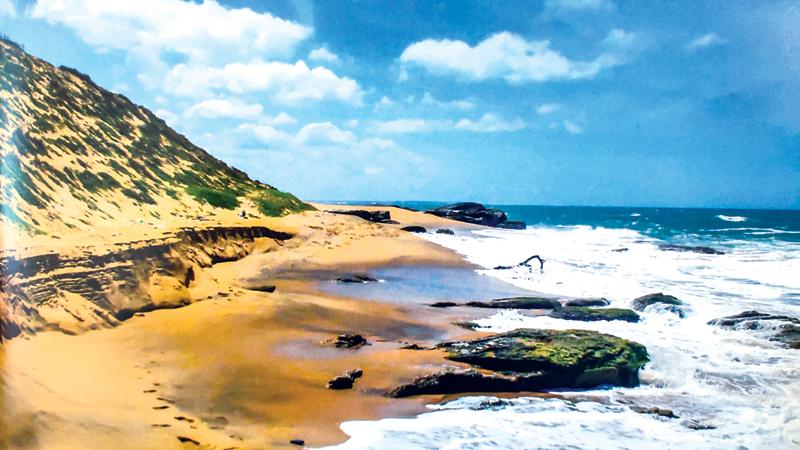
Title: Kingdom of Ruhuna: Home of the Ruhunu National Park
Author: Suriya Jayalath Perera
Publisher: America Sri Lankan Art Society
In an era when the teardrop of the Indian ocean is living up to its name, it is refreshing to come across a book that highlights all that is good and mesmerising on this land of incomparable beauty, strength and resilience.
While highlighting the beauty and the history of the Southern coastal belt of Sri Lanka, Suriya Perera’s ‘Kingdom of Ruhuna: Home of the Ruhunu National Park,’ also comes across as a testimony to why we write books about the things we love; it is an exercise in aligning our thoughts in a logical sequence, a display of our creative skills, and above all the fulfillment of a wish to share our experiences with others.
 Besides the elaborate descriptions and eye-catching photographs, Manjula Kumara Gamage’s exceptional cover design and page layout act as a magnet to draw the attention of even the most reluctant reader to this coffee-table book of no less than 235 pages.
Besides the elaborate descriptions and eye-catching photographs, Manjula Kumara Gamage’s exceptional cover design and page layout act as a magnet to draw the attention of even the most reluctant reader to this coffee-table book of no less than 235 pages.
Nature, wildlife and history
Currently, the founder President of the America Sri Lankan Photographic Art Society, and formerly the project officer of the Central Regional Office of the Department of Wildlife Conservation, Suriya’s ‘Kingdom of Ruhuna’ is the culmination of two and a half years of research in the Yala National Park.
In the back cover blurb Suriya writes it was his fascination for nature, wildlife and history that inspired him to publish the book. In addition, Manjula’s brilliant page layout makes a massive impact on how the text and photos are perceived. The way in which Manjula balances words and photos on a page radiating an in-depth awareness of aesthetics ensures that the key messages in Suriya’s narrative are effectively conveyed to the reader.
A close scrutiny of the book results in an encounter with the sun-drenched valleys of Yala and the kingdom that once existed on this special stretch of land known simply as Ruhuna. The Buddha statues, ancient ruins such as the Akasa Chaithya, artefacts of old windows and door frames found at Mandagala and Kanabisawgala open a path to the past when ancestors of King Dutugamunu ruled this region.
 As Dr. Nandasiri Jasentuliyana writes in his introduction, according to legendary Sri Lankan history, this “jungle home” nurtured and protected one of the greatest kings of Sri Lankan history, King Dutugamunu. Legend has it that the king took refuge in Mahagama and prepared to wage war with his brother Tissa. Traces of those who once walked this land, their lives and their beliefs are visible to this day in every tank, pond, dagoba and painting, writes Suriya, inviting us to perceive a heritage built on “the blood and sweat of our ancestors.”
As Dr. Nandasiri Jasentuliyana writes in his introduction, according to legendary Sri Lankan history, this “jungle home” nurtured and protected one of the greatest kings of Sri Lankan history, King Dutugamunu. Legend has it that the king took refuge in Mahagama and prepared to wage war with his brother Tissa. Traces of those who once walked this land, their lives and their beliefs are visible to this day in every tank, pond, dagoba and painting, writes Suriya, inviting us to perceive a heritage built on “the blood and sweat of our ancestors.”
Thus, as Dr. Jasentuliyana said, ‘Kingdom of Ruhuna’ embodies a “painstaking journey of discovery through an area rich in archaeological sites, some of which are rarely visited and barely known even to historians.”
Perhaps, what is even more captivating is the glimpse of that other kingdom the pages of ‘Kingdom of Ruhuna’ reveal; the kingdom of nature. Armed with what he calls his love of mother nature, Suriya’s portrayals of the sweeping beaches, soaring monoliths and spectacular sunsets reflect positive vibes and sooth furrowed brows caught up in the turmoils of day to day life in 21st century Sri Lanka.
Splendour of nature
The photographs of a green bee-eater in mid flight, a meeting chaired by wild buffaloes and pelicans, an elephantine smile after a drink of cool water and a leopard looking straight into the camera as if to ask ‘What’s your problem, bro?’ speak of the splendour of nature in and around the Manik Ganga, the Kumbuk Oya and the Patanagala beach secure under the watchful eyes of the Gal Kanda mountains.
Suriya’s lens effectively captures the ways the natural kingdom remain united under a hierarchy which continues in the face of many challenges. The true owners of Yala, from the majestic leopards to the slim black storks, portray a balance and a serenity that contrast sharply with the upheavals in the ‘human’ kingdom of Ruhuna. Some of the photographs here will stick with you long after you have closed the book.
The text and photographs, therefore, are predominantly a celebration of what we still have here in Sri Lanka, rather than what we have lost by our reckless interventions. The book evokes gratitude towards our stunning land, rather than guilt at how we have destroyed it. Best of all, it challenges us all to be good citizens, to put our differences aside and protect this land replete with wild animals, plants and a majestic legacy. This book is as positive and spectacular as the sun-drenched valleys of Yala.
